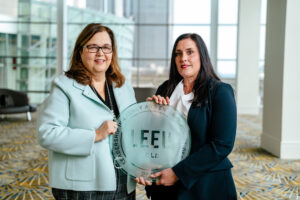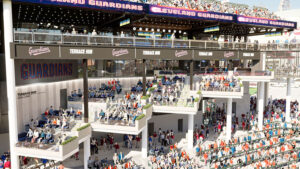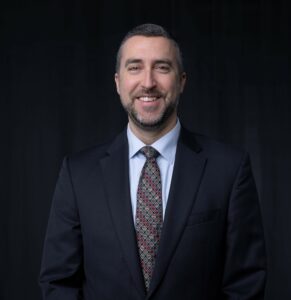Huntington Place Re-certifies as the Largest LEED Facility in Michigan
By Mary Klida
Karen Totaro, CVE, general manager for Huntington Place/ASM Global, announced that Huntington Place in Detroit has again achieved LEED Gold status by recertifying under the LEED v4.1 O+M rating system, the most robust, flexible, and transparent rating system to date.
LEED or Leadership in Energy & Environmental Design is a globally recognized symbol of excellence in green building. LEED certification ensures electricity cost savings, lower carbon emissions and healthier environments where people live, work, learn, play, and worship. In the United States alone, buildings account for almost 40 percent of national CO2 emissions, but LEED-certified buildings have 34 percent lower CO2 emissions, consume 25 percent less energy and 11 percent less water, and have diverted more than 80 million tons of waste from landfills.
“To keep a high-performing green building, the Huntington Place team is dedicated to ongoing performance  measurement and training,” said Becky Bixby (pictured on right next to Karen Totaro), assistant general manager Huntington Place/ASM Global and LEED project manager. “We invest in educating employees, vendors, customers, partners, and visitors on our efforts and the importance of sustainable practices.”
measurement and training,” said Becky Bixby (pictured on right next to Karen Totaro), assistant general manager Huntington Place/ASM Global and LEED project manager. “We invest in educating employees, vendors, customers, partners, and visitors on our efforts and the importance of sustainable practices.”
Huntington Place was recognized by LEED for several best practices resulting in the certification. The project scored very high in Human Experience which includes an Indoor Air Quality Evaluation – and demonstrates the building has excellent ventilation and air quality.
During the COVID-19 Pandemic while Huntington Place was closed for business, Gretchen Whitmer, Michigan’s Governor, asked venue leadership to work with FEMA and become a field hospital and vaccine distribution center. The temporary site was designed to relieve the burden on local hospitals treating patients with COVID-19, equipped with patient oxygen supply and negative air pressure to accommodate healing.
Environmental air quality in the Atwater Garage was monitored in real-time for CO levels in the garage with 48 sensor readings that signal the engineering team to turn on the required sequence of 17 variable-speed exhaust fans. A twelve-foot by ten-foot video monitor with mapped locations of all CO sensors and exhaust fans is located in the engineering control room and watched by team members.
Both endeavors contributed to high scores for Huntington Place in the LEED Indoor Air Quality Evaluation and recertification as a LEED Gold building noting that the building was managed and controlled for minimum energy and water usage (or high energy/water performance) despite changes in occupancy, usage, or operations is really commendable.
The venue’s performance for water use was also highly rated. The building uses less water per square feet and per person than the local average through the use of very low flow plumbing fixtures and optimal cooling tower maintenance and operations.
Sustainability innovation is part of the venue’s Green mission, and new and innovative Green initiatives are continually implemented throughout the facility. Last month the Huntington Place Green Committee installed large recycling cages in the back of the house of exhibit halls to make it easier for labor building and deconstructing event spaces to recycle wood, glass, metal, and other materials that can be collected and moved along material life cycles to stay out of the waste stream.
This month, Bixby officially became a LEED Green Associate, a professional credential highlighting her understanding of green building design, construction, and operations attained after 16 hours of course work and exams. “I’m excited to be on this journey to help make Huntington Place a more sustainable venue for our customers and employees,” she said.
In 2020, Huntington Place received the Leadership Award from the USGBC in recognition of leadership in driving the adoption of Leadership in Energy and Environmental Design (LEED) across business portfolios, higher education and green affordable housing, as well as helping to advance Environmental, Social and Governance (ESG) performance, resilience planning and innovative waste management solutions. Leadership Award recipients are a model for how LEED and other sustainability practices can be used to improve communities, support business, and contribute to a better future for all.
“Achieving LEED certification is more than just implementing sustainable practices. It represents a commitment to making the world a better place and influencing others to do better,” said Peter Templeton, president and CEO, USGBC. “Given the extraordinary importance of climate protection and the central role buildings play in that effort, Huntington Place is creating a path forward through their LEED certification.”
LEED is the most widely used green building rating system and a symbol of international excellence. Green buildings allow venues like Huntington Place to operate more sustainably and provide a healthier, more comfortable space for people to enjoy. More than 98,500 commercial and institutional projects are currently participating in LEED, comprising more than 21 billion square feet of construction space in all 50 states and more than 175 countries and territories. There are 213 LEED certified buildings in the Metro Detroit area.
“Huntington Place’s LEED certification demonstrates tremendous green building leadership,” said Templeton. “LEED was created to make the world a better place and revolutionize our buildings and communities by providing everyone with access to healthy, green, and high performing buildings. Huntington Place is a prime example of how the innovative work of project teams can create local solutions that contribute to making a global difference.”
The convention center maintains its status as the largest LEED certified venue in Michigan.
Cleveland Guardians Announce Three-Year Renovation Project of Progressive Field
By MLB.com
The Cleveland Guardians announced renovation projects that are scheduled to be completed over the next three years as a result of the Cleveland Guardians new lease extension at Progressive Field announced last year.
Progressive Field Reimagined will improve and extend the life of Progressive Field, which is the 11th-oldest ballpark in Major League Baseball, and will include renovations to the Upper Deck, Terrace Club, Dugout Club, home and visiting Clubhouses & Service Level, and the Guardians Administrative Offices.
“Progressive Field has been a fantastic home to Cleveland Baseball since it opened in 1994,” said  Cleveland Guardians Owner, Chairman and Chief Executive Officer Paul Dolan. “We are excited to continue to call Progressive Field home for decades to come, and we look forward to providing new experiences and updated enhancements to our fans, players, and staff through renovation projects that will continue to keep our ballpark competitive as one of the best venues in Major League Baseball.”
Cleveland Guardians Owner, Chairman and Chief Executive Officer Paul Dolan. “We are excited to continue to call Progressive Field home for decades to come, and we look forward to providing new experiences and updated enhancements to our fans, players, and staff through renovation projects that will continue to keep our ballpark competitive as one of the best venues in Major League Baseball.”
“The new fan-facing renovation projects have a heavy emphasis on social experiences at the ballpark,” said President of Business Operations Brian Barren. “As we surveyed our fans, we continuously heard feedback that aligned with the success we saw with the Corner Bar – a focus on more social spaces and compelling fan experiences in the ballpark offering unique ways to enjoy a game. We believe our renovation projects which include a revamped Upper Deck, a reimagined Terrace Club space (which will be renamed the Terrace Hub), and a new Dugout Club will deliver new unique experiences for fans at Progressive Field.”
“Year over year we are continuously striving to achieve our ultimate goal of winning a World Series Championship for the City of Cleveland,” said President of Baseball Operations Chris Antonetti. “To achieve that goal, we need to provide our players the adequate space and amenities to focus on training, recovery and rehabilitation, and those will be the biggest focus areas as we build out the renovated clubhouse space.”
The scheduled renovation projects will focus on the following areas:
Revamped Upper Deck
The revamped Upper Deck will feature multiple social spaces for fans to enjoy the game. The new-look Upper Deck will feature a Beer Garden down the left field line, a new group outing space in right field, and new concession spaces, including two new View Box bars that will flank home plate and allow for more open sightlines from the Upper Deck concourse.
Terrace Hub
The current Terrace Club will be reimagined as an open-air hub with terraced-ticketed seating on the 200 and 300-levels, and a new expansive authentic-to-Cleveland Beer Hall food and beverage experience on the 400-level that will be open to all ticketed patrons at Progressive Field. The ticketed seating sections will have their own private club space on the 300-level.
Dugout Club
The new Dugout Club will combine the best of both worlds when it comes to premium seating, allowing for the same great field-level seats that currently exist while creating a new exclusive lounge behind home plate. The Club will also feature seven private lounges to allow for groups to enjoy an exclusive experience.
Clubhouses & Service Level
Both clubhouses, as well as the ballpark Service Level, will be updated for the first time since the ballpark opened in 1994. The new home clubhouse will be completely reimagined with a focus on player amenities in performance, training, and recovery.
Through these renovations, we will significantly improve our ability to support player preparation, performance, and recovery through expanded and enhanced strength and conditioning and athletic training areas, improved kitchen facilities, more robust technological support for players, coaches, and staff members, among other improvements.
E. 9th Street Building
To allow for the clubhouse expansion, a new four-level E. 9th street building will be erected in right field to allow for a new kitchen and commissary for the Guardians concessionaire, as well as additional storage facilities for the ballpark. The rooftop of the new E. 9th street building will connect to the Upper Concourse and serve as a new group space at Progressive Field.
Cleveland Guardians Front Office
The Guardians Front Office will also be fully renovated for the first time since 1994. As part of the renovation, the Guardians will add a fifth floor to the current four-level structure.
Project Funding
The funding for the projects will be supported by the new lease agreement which extends the current lease to 2036 (with potential options to extent to 2046) and was agreed upon between the City of Cleveland, Cuyahoga County, State of Ohio, the Gateway Economic Development Corporation of Greater Cleveland and the Cleveland Guardians. The estimated total of the projects will be $202.5 million with $67.5 million coming from the Cleveland Guardians. The Guardians are also responsible to provide additional funds to cover cost overages, if any, that may result from the projects.
Project Timing
The Guardians expect all renovations to be completed by the 2025 season. The schematic design process is close to completion, and the majority of the 2023 season will focus on design development with the hope of starting construction at the end of the 2023 season.
2024 Opening Day Project Completion:
Upper Deck Experience
E. 9th Street Building
2025 Opening Day Project Completion:
Terrace Hub
Dugout Club
Clubhouses & Service Level
Administrative Offices
Manica is serving as the lead design architect on the finalized projects, while Ohio based Moody Nolan – the largest African American Architecture firm in the US – is serving as the architect of record.
Mortenson is the national construction manager while Northeast Ohio’s Independence Construction will work with Mortenson in providing construction management services.
The Guardians and Gateway have made our Community Benefits Programs a priority to set project goals for contracting diverse businesses, hiring local and minority workforces, expanding training programs and studying best practices for improving diversity and inclusion in the construction, engineering, and architecture industries. As another example of this focus, the Guardians recently announced the selection of a diverse small locally owned business, The AKA Team, to serve as an additional Associate Construction Manager for the project. The AKA Team is a local minority and female-owned company and a certified Cleveland Small Business, that has been in business since 2009.
Welcome to Our Newest Members

Please welcome our newest members who joined IAVM in December 2022. Thank you for being a part of the association! Also, let us get to know you better by participating in the I Am Venue Management series. Please visit http://www.iavm.org/i-am-venue-management-share-your-story to share your story and photo.
Phil Adams, Vancouver Convention Centre, Vancouver, BC, Canada
Lisa Allen, Curtis Culwell Center, Garland, TX
Shawn Anderson, Lethbridge & District Exhibition, Lethbridge, AB, Canada
Connor Ayers, Climate Pledge Arena, Seattle, WA
Georon Baker, Nationals Park – Washington Nationals, Washington, DC
Courtney Barnes, Meydenbauer Center, Bellevue, WA
Angelica Barrios, Tampa Convention Center, Tampa, FL
Megan Barry, New Jersey Performing Arts Center (NJPAC), Newark, NJ
Jessica Belisle, Mesa Convention Center, Mesa, AZ
Melissa Berntsen, Oregon Convention Center – Group 2, Portland, OR
Patrick Blackburn, USM Falcon, Elmhurst, IL
Cara Blakeslee, Jeanne B. McCoy Community Center for the Arts, New Albany, OH
Kaylee Blumenfeld, University of Mary Hardin-Baylor, Belton, TX
Shannon Boone, INTRUST Bank Arena, Wichita, KS
Nick Brazelton, Belmont University, Strategic Venues and Event Services, Nashville, TN
Bryan Brown, Oregon Convention Center, Portland, OR
Caryn Brown, Climate Pledge Arena, Seattle, WA
Lolitta Brown, Oregon Convention Center, Portland, OR
David Cappiello, Birmingham Jefferson Convention Complex, Birmingham, AL
Kristen Carter, Saenger Theatre, Pensacola, FL
Maurizia Cecconi, Oregon Convention Center, Portland, OR
Wes Chadwick, Meydenbauer Center, Bellevue, WA
Nia Colemon, Oregon Convention Center, Portland, OR
Mike Conway, Overture Center for the Arts, Madison, WI
Steve Cook, Blumenthal Performing Arts, Charlotte, NC
Parker Costello, Lower.com Field, Columbus, OH
Quentin Crump, Denver Center for the Performing Arts, Denver, CO
Cathy Damiano, CAJUNDOME & Convention Center, Lafayette, LA
Frank DePizzo, Lower.com Field, Columbus, OH
Jim Dermody, Climate Pledge Arena, Seattle, WA
Brittan Drake, Meydenbauer Center, Bellevue, WA
Kate Edge, Bridgestone Arena, Nashville, TN
Chase Finch, Tampa Convention Center, Tampa, FL
Scott Fitzgerald, Dayton Live, Dayton, OH
Vern Frisbie, Argus Event Staffing, LLC, Denver, CO
Taurus Gadsden, Tampa Convention Center, Tampa, FL
Anna Garcia-Menocal, Overture Center for the Arts, Madison, WI
Ramona Goia, Meydenbauer Center, Bellevue, WA
Josh Greenwood, Argus Event Staffing, LLC, Denver, CO
Jess Griggs, Austin Theatre Alliance, Austin, TX
John Hale, Century II Performing Arts and Convention Center, Wichita, KS
Ellen Hamiel, Wisconsin Center District, Milwaukee, WI
Tyler Harbison, Lower.com Field, Columbus, OH
Michael Hepburn, FTX Arena, Miami, FL
Kelli Hill, Bridgestone Arena, Nashville, TN
Ryan Hiser, Tampa Convention Center, Tampa, FL
Sam Hof, Lower.com Field, Columbus, OH
Jennifer Hoffman, Your-Type 3D Letters/Shapes, Winona, MN
Steven Hollis, SAFE Credit Union Convention and Performing Arts District, Sacramento, CA
Ellott Ivie, Arts and Venues Denver, Denver, CO
Amanda Jenkins, Oregon Convention Center, Portland, OR
David Jeppesen, Oregon Convention Center, Portland, OR
Danny Johnson, Qwick, Scottsdale, AZ
Kasey Johnson, Argus Event Staffing, LLC, Denver, CO
Sara Khanifar, BC Place, Vancouver, BC, Canada
Patria Kishida, Vancouver Convention Centre, Vancouver, BC, Canada
Nicole Klein, Birmingham Jefferson Convention Complex, Birmingham, AL
Matthew Kline, USM Falcon, Elmhurst, IL
Kaitlyn Konrardy, Overture Center for the Arts, Madison, WI
Sydney Koppe, Lethbridge & District Exhibition, Lethbridge, AB, Canada
AnnMarie Lane, Ralph Englestad Arena, Grand Forks, ND
Emily Larkin, Century II Performing Arts and Convention Center, Wichita, KS
Jon Letchford, USM Falcon, Elmhurst, IL
Travis Ligon, Alliant Energy PowerHouse, Cedar Rapids, IA
Emily Lovgren, Belmont University, Strategic Venues and Event Services, Nashville, TN
Michelle Lovrics, Exhibition Place, Toronto, ON, Canada
Richard Lufriu, Tampa Convention Center, Tampa, FL
Dustin Malanga, SAFE Credit Union Convention and Performing Arts District, Sacramento, CA
James Malcolm, Tampa Convention Center, Tampa, FL
Craig Manfra, The Rooftop at Pier 17, New York, NY
Fawn Martin, SAFE Credit Union Convention and Performing Arts District, Sacramento, CA
Martha Martinez, University of California San Diego, La Jolla, CA
Micah McBay, Greenville Municipal Auditorium, Greenville, TX
Michael McClelland, BC Place, Vancouver, BC, Canada
Derrick McElwee, Wisconsin Center District, Milwaukee, WI
Stacy McGlinnen, Tampa Convention Center, Tampa, FL
Angelina Medina, Tampa Convention Center, Tampa, FL
Andrew Miller, Lower.com Field, Columbus, OH
Bailey Morris, Tampa Convention Center, Tampa, FL
Evan Mues, Meydenbauer Center, Bellevue, WA
Anthony Nelson, Grossinger Motors Arena, Bloomington, IL
Erika O’Brien, Tampa Convention Center, Tampa, FL
Jim Olachea, Tampa Convention Center, Tampa, FL
David Oster, Alliant Energy PowerHouse, Cedar Rapids, IA
Charity Pettit, Alliant Energy PowerHouse, Cedar Rapids, IA
Brad Powers, Century II Performing Arts and Convention Center, Wichita, KS
Kristi Powers, Tampa Convention Center, Tampa, FL
Ellen Race, Lower.com Field, Columbus, OH
Rebecca Rainey, Busch Systems, Barrie, ON, Canada
Loren Rider, Alliant Energy PowerHouse, Cedar Rapids, IA
Jo’Nyee Robinson, Oregon Convention Center, Portland, OR
Lindita Rugova, The Rooftop at Pier 17, New York, NY
Brice Schroeder, Jerome Schottenstein Center, Columbus, OH
Suzanne Seder, Tampa Convention Center, Tampa, FL
Neil Segal, VenuWorks of Burnsville, Burnsville, MN
Brynn Showalter, Tampa Convention Center, Tampa, FL
Mack Smith, SAFE Credit Union Convention and Performing Arts District, Sacramento, CA
Kristen Sten, The Greek Theatre, Los Angeles, CA
Janna Stephens, Tampa Convention Center, Tampa, FL
Alexander Suciu, Capital One Center, Tysons, VA
Caleigh Sullivan, Arts and Venues Denver, Denver, CO
Ariana Techere, Vancouver Convention Centre, Vancouver, BC, Canada
Tracy Thornton, Meydenbauer Center, Bellevue, WA
Patrick Tsai, Vancouver Convention Centre, Vancouver, BC, Canada
Shenita Urquhart, MetLife Stadium, East Rutherford, NJ
Mike Watkins, SAP Center at San Jose, San Jose, CA
Tracey Welsh, Alliant Energy PowerHouse, Cedar Rapids, IA
Casey White, CAJUNDOME & Convention Center, Lafayette, LA
Joyce White, Alliant Energy PowerHouse, Cedar Rapids, IA
Amanda Wilkins, Cobb Energy Performing Arts Centre, Atlanta, GA
Vanessa Williams, CAJUNDOME & Convention Center, Lafayette, LA
Shawn-Ta Wilson, Tampa Convention Center, Tampa, FL
Marye Winterlin Benjamin, SAFE Credit Union Convention and Performing Arts District, Sacramento, CA
Cam Wirt, Lower.com Field, Columbus, OH
Jason Ybarra, Century II Performing Arts and Convention Center, Wichita, KS
Morgan Yirkovsky, Alliant Energy PowerHouse, Cedar Rapids, IA
Kevin Young, Alliant Energy PowerHouse, Cedar Rapids, IA
Brad Gessner, CVE, Takes Readers “Backstage” in His New Book About the Industry
By R.V. Baugus
Long-time IAVM member and good friend Brad Gessner, CVE, is now living the charmed life of retirement nestled in the Hill Country of Texas. Specifically, Brad resides in Comfort, a town that easily befits its name and is a far cry from the hectic pace of Brad’s final job in running the Los Angeles Convention Center.
Brad shared an interesting story about how he started keeping a journal of interesting stories beginning  in 1984 about life in the public assembly venue industry. For the younger IAVM members reading this, it is something you might want to contemplate doing as well. At the minimum, it will provide you some fond (and maybe not so fond) memories of your career in this fascinating business once you hit the retirement calling.
in 1984 about life in the public assembly venue industry. For the younger IAVM members reading this, it is something you might want to contemplate doing as well. At the minimum, it will provide you some fond (and maybe not so fond) memories of your career in this fascinating business once you hit the retirement calling.
Brad’s journaling resulted in his writing a book entitled Backstage, an apt title if there ever was one. We’ll let Brad tell the back story of Backstage in his own words. I am looking forward to reading the book and encourage you to do the same.
“I actually started in 1984 keeping a journal of interesting stories that happened on the job in this crazy and interesting industry. I kept writing them down for the next 36 years!
“I wrote it for several reasons. I wanted to leave my story for my kids and grandkids as well as share with the industry and anyone else that was interested. And to make others aware of an incredible industry that I discovered completely by accident.”
The book’s description is as follows:
Backstage is a behind-the-scenes tour of the author’s best memories of what transpires in the world of special events. The author’s 42-year career managing special event facilities include his introduction to this “accidental industry” starting in 1978 through his retirement in 2020. From the Harlem Globetrotters, Earl Scruggs, Harry Chapin and EDM’s Kaskade to wrestling’s Dusty Rhodes and comedic genius Gallagher, Backstage stories make this a fun, insightful and wanting to read the next page.
Backstage is also a book about the highs and lows of leading in the event industry. The author held leadership positions at the San Diego Convention Center (two different stints), WestWorld of Scottsdale, the Del Mar Fairgrounds & Racetrack, the HemisFair Arena, and his last stop as Sr. Vice President of Convention Centers for AEG Facilities and General Manager of the Los Angeles Convention Center.
Backstage challenges us to ensure our leadership makes a difference. If you are a leader in any industry, read this book!
The author offers ideas and insights and pragmatic guidance which will help lead you to greater success as a leader.
The book is available through Amazon and can be found by clicking here.
CRVA Appoints Bryan Miller to General Manager for the Charlotte Convention Center
By Kelly Greenfield
Bryan Miller has been named General Manager for the Charlotte Convention Center, which recently completed a $126.9M expansion, increasing total leasable space to 600,000 sq. ft., and is operated by the Charlotte Regional Visitors Authority (CRVA). Miller will oversee the Charlotte Convention Center team and will collaborate with Visit Charlotte, the NASCAR Hall of Fame, and other key stakeholders.
Miller joins the CRVA with an extensive background in the hospitality industry and venue management  community, previously working with the Virginia Beach Convention Center, where he served for 16 years, starting as an Event Manager with promotions to Sales Manager (2007), Assistant General Manager (2011) and General Manager (2020), managing events as large as 35,000 attendees. Miller’s leadership was key to the recovery of the Convention Center and hospitality community in Virginia Beach. He has served in the International Association of Venue Managers (IAVM) Mentor program, Convention Center Committee and is currently Chairman of IVAM’s Region 5 Chapter Meeting Committee and a Certified Venue Executive (CVE).
community, previously working with the Virginia Beach Convention Center, where he served for 16 years, starting as an Event Manager with promotions to Sales Manager (2007), Assistant General Manager (2011) and General Manager (2020), managing events as large as 35,000 attendees. Miller’s leadership was key to the recovery of the Convention Center and hospitality community in Virginia Beach. He has served in the International Association of Venue Managers (IAVM) Mentor program, Convention Center Committee and is currently Chairman of IVAM’s Region 5 Chapter Meeting Committee and a Certified Venue Executive (CVE).
“The CRVA prides itself in assembling the most professional talent available and we are very proud to announce Bryan Miller as the newest member of the team,” said Steve Bagwell, Vice President of Venues at the CRVA. “Bryan’s extensive experience, exceptional customer service, innovative leadership, and collaborative nature will be valuable to both our customers and teammates.”
Miller officially assumes his duties at the CRVA on Jan. 23 and will report directly to Steve Bagwell, Vice President of Venues at the CRVA.
Kelly Greenfield is Senior Public Relations Manager at the Charlotte Regional Visitors Authority.
Do you want to receive a Front Row News weekly digest?
Categories
- Allied (861)
- Architecture (147)
- Arenas (747)
- Career (897)
- Convention Centers (895)
- Education (623)
- Events (1,544)
- Food & Beverage (193)
- Foundation (113)
- Guest Experience (1,496)
- Industry News (2,270)
- Leadership (1,888)
- Marketing (150)
- Membership (2,000)
- Music (213)
- Performing Arts Centers (454)
- Professional Development (409)
- Research (127)
- Safety & Security (442)
- Sports (763)
- Stadiums (608)
- Student (159)
- Technology (516)
- Ticketing (92)
- Touring (82)
- Trends (364)
- Uncategorized (742)
- Universities (218)
- Video (25)
- Young Professional (198)
Twitter Feed
- Twitter feed loading
Recent Posts
- Seattle Convention Center Announces Strategic Leadership Appointment and Growth Initiatives for 2026
- Peggy Daidakis Humbly Made Convention Center History
- Welcome to Our Newest Members
- New Member Benefit! IAVM Partners with Advantage Training to Elevate Staff Readiness and Guest Experience
- Charlotte Convention Center Welcomes Two New Leaders to its Management Team
Categories
- Allied
- Architecture
- Arenas
- Career
- Convention Centers
- Education
- Events
- Food & Beverage
- Foundation
- Guest Experience
- Industry News
- Leadership
- Marketing
- Membership
- Music
- Performing Arts Centers
- Professional Development
- Research
- Safety & Security
- Sports
- Stadiums
- Student
- Technology
- Ticketing
- Touring
- Trends
- Uncategorized
- Universities
- Video
- Young Professional
Archives
- December 2025
- November 2025
- October 2025
- September 2025
- August 2025
- July 2025
- June 2025
- May 2025
- April 2025
- March 2025
- February 2025
- January 2025
- December 2024
- November 2024
- October 2024
- September 2024
- August 2024
- July 2024
- June 2024
- May 2024
- April 2024
- March 2024
- February 2024
- January 2024
- December 2023
- November 2023
- October 2023
- September 2023
- August 2023
- July 2023
- June 2023
- May 2023
- April 2023
- March 2023
- February 2023
- January 2023
- December 2022
- November 2022
- October 2022
- September 2022
- August 2022
- July 2022
- June 2022
- May 2022
- April 2022
- March 2022
- February 2022
- January 2022
- December 2021
- November 2021
- October 2021
- September 2021
- August 2021
- July 2021
- June 2021
- May 2021
- April 2021
- March 2021
- February 2021
- January 2021
- December 2020
- November 2020
- October 2020
- September 2020
- August 2020
- July 2020
- June 2020
- May 2020
- April 2020
- March 2020
- February 2020
- January 2020
- December 2019
- November 2019
- October 2019
- September 2019
- August 2019
- July 2019
- June 2019
- May 2019
- April 2019
- March 2019
- February 2019
- January 2019
- December 2018
- November 2018
- October 2018
- September 2018
- August 2018
- July 2018
- June 2018
- May 2018
- April 2018
- March 2018
- February 2018
- January 2018
- December 2017
- November 2017
- October 2017
- September 2017
- August 2017
- July 2017
- June 2017
- May 2017
- April 2017
- March 2017
- February 2017
- January 2017
- December 2016
- November 2016
- October 2016
- September 2016
- August 2016
- July 2016
- June 2016
- May 2016
- April 2016
- March 2016
- February 2016
- January 2016
- December 2015
- November 2015
- October 2015
- September 2015
- August 2015
- July 2015
- June 2015
- May 2015
- April 2015
- March 2015
- February 2015
- January 2015
- December 2014
- November 2014
- October 2014
- September 2014
- August 2014
- July 2014
- June 2014
- May 2014
- April 2014
- March 2014
- February 2014
- January 2014
- December 2013
- November 2013
- October 2013
- September 2013
- August 2013
- July 2013
- June 2013
- May 2013
- April 2013
- March 2013
- February 2013
- January 2013
- May 2012
- March 2012
- December 2011
- November 2011
- October 2011
Recent Comments
- Frank Bradshaw, Ph.D., CVE on John Meyer, CVE, a Tireless Advocate of Certification for Venue Professionals, Has Died
- Neil Sulkes on Hilary Hartung, Friend to Many in Venue Marketing, Has Left Us
- Jason Parker, CVE on The Devastation of Hurricane Helene and How We Can Support One Another
- Larry Perkins on Touhey Testifies Against Speculative Ticketing Before Congressional Subcommittee
- Peter Secord on Major Players for Planned Elkhart Amphitheater Were in the Mix at VenueConnect
